It is considered the seventh planet in our solar system according to its proximity to the Sun. Mercury is the closest, and Neptune is the farthest. Furthermore, we can see that among the large planets (called gas giants), Uranus ranks third.
It has a diameter of 51.118 km and is 20 times more distant from the Sun than our planet. Its name was given in honor of the Greek god Uranus. Unlike other planets that are rocky or have quite chaotic structures, Uranus has a fairly uniform and smooth surface. Blue to green is not a reflection of the inclination of the sun's rays. It is the combination of gases that gives it its color.
To see it from Earth, the night sky must be very dark, with the Moon in a new phase (see . . If these conditions are met, we can easily find that green blue dot with binoculars.
The scientist who discovered this planet was William Herschel and he did so on March 13, 1781. During this time, many people were trying to find out more about our sky and discover what was in outer space. To discover Uranus, Herschel used a telescope he built himself. Spotting the greenish-blue dot in the sky, he reported that it was a comet. But after examining it, it was found to be a planet.
It is the sixth planet in the solar system after Jupiter. Its orbit is quite large and it takes about 84 years compared to how far it can travel around the Earth. That is, while our planet has circled the Sun 84 times, Uranus has made only one.
It is about four times the size of our planet and its density is only 1.29 grams per cubic centimeter. In its interior composition we find different types of rock and ice materials. The rocky core is quite abundant and the most abundant gases in its atmosphere are hydrogen and helium.
That is why it is called a gas giant. The inclination of its axis of rotation is about 90 degrees with respect to its orbit. We think that 23 degrees of our planet. Uranus also has a ring similar to Saturn, although it is not the same size. Axis tilts also affect the rings and their satellites.
Because of this inclination of its axis, Uranus has only two seasons of the year. The Sun illuminates one pole of the planet for 42 years and one pole for the other 42. Being so far from the sun, its average temperature is about -100 degrees.
It has a ring system that has nothing to do with Saturn and is also made up of dark particles, just like science, many important discoveries happen by chance and reverse when looking for the best. These rings were discovered in 1985 when the Voyager 2 space probe was trying to reach Neptune. It was then that he saw the rings of Uranus in his passage.
With the most modern and advanced technology it was possible to know that one of its rings is blue and the other is red.
A typical thing for planets that have rings is that they are red. But it is very lucky to find blue rings. Its atmosphere and interior consist of 85% hydrogen, 15% helium and some methane. This composition makes it greenish blue in color.

This planet has a liquid ocean, although it has nothing to do with our Earth. Its atmosphere, consisting of the previously named gases, dries up as it descends until all the ice is covered by water, ammonia, and methane gases. We have said that the ocean is unlike anything on Earth and that is because it is made of water and ammonia. This makes it a high electrical conductivity and is completely dangerous.
Unlike other gas giants like Jupiter and Saturn, on Uranus, ice dominates over gas due to its distance from the Sun. The temperature is much lower and this has led the scientific community to regard them as ice giants. Scientists don't know what caused its axis to be so vulnerable, although it is thought that it may have collided with another protoplanet or some large rock during its formation, and it took the axis as a result of the impact.
It has 27 satellites, some of which are better known than others. Satellites are not large enough to have their own atmospheres. They were also discovered by the Voyager 2 probe and have been named Titania and Oberon. Another one called Miranda is made of water and dust ice and is the steepest in the entire solar system. It is more than 20 km high. It is 10 times larger than the Grand Canyon of our planet.
Hi, @emon01,
Thank you for your contribution to the Blurt ecosystem.
Your post was picked for curation by @onchain-curator.
Please consider voting for our Upkeep Proposal by Symbionts.